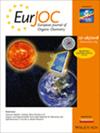A Meta‐Analysis of Published Brønsted Plots Supports Brønsted's “Conventional” pKa Values: 14.00 for Water and 0.00 for H+(aq)
IF 2.5
3区 化学
Q2 CHEMISTRY, ORGANIC
引用次数: 0
Abstract
In the early 1900s, Brønsted used two different pairs of pKa values for water and the aqueous proton: He denoted 14.00 and 0.00 (respectively) as the “conventional” values, and 15.74 and −1.74 (respectively) as the “rational” values. Although the conventional values have been supported by both experiment and theory, the rational values have been employed in the vast majority of studies involving Brønsted plots up to the present day. Here we present a meta‐analysis of 67 Brønsted plots published from 1924 to 2010, revealing that rational pKa’ values more frequently appear as statistical outliers (a greater than 80 % rejection rate) compared to conventional values (a roughly 50 % rejection rate) based on Q‐tests. Furthermore, in 85 % of examined plots, the conventional points align more closely with best‐fit lines. An evaluation of Hupe and Pohl's Marcus plots also shows a somewhat better fit with the conventional rather than the rational pKa’ values. Finally, in the bond length versus pKa investigations published by Brydon et al., all the rational points were statistically rejected, whereas the conventional values were accepted. From our statistical analyses, we conclude that a convincing majority of experimental evidence from published Brønsted plots leads one to question the validity of Brønsted's rational pKa’ values for water and the aqueous proton (15.74 and −1.74, respectively).

求助全文
约1分钟内获得全文
求助全文
来源期刊
CiteScore
5.40
自引率
3.60%
发文量
752
审稿时长
1 months
期刊介绍:
The European Journal of Organic Chemistry (2019 ISI Impact Factor 2.889) publishes Full Papers, Communications, and Minireviews from the entire spectrum of synthetic organic, bioorganic and physical-organic chemistry. It is published on behalf of Chemistry Europe, an association of 16 European chemical societies.
The following journals have been merged to form two leading journals, the European Journal of Organic Chemistry and the European Journal of Inorganic Chemistry:
Liebigs Annalen
Bulletin des Sociétés Chimiques Belges
Bulletin de la Société Chimique de France
Gazzetta Chimica Italiana
Recueil des Travaux Chimiques des Pays-Bas
Anales de Química
Chimika Chronika
Revista Portuguesa de Química
ACH—Models in Chemistry
Polish Journal of Chemistry.

 求助内容:
求助内容: 应助结果提醒方式:
应助结果提醒方式:


